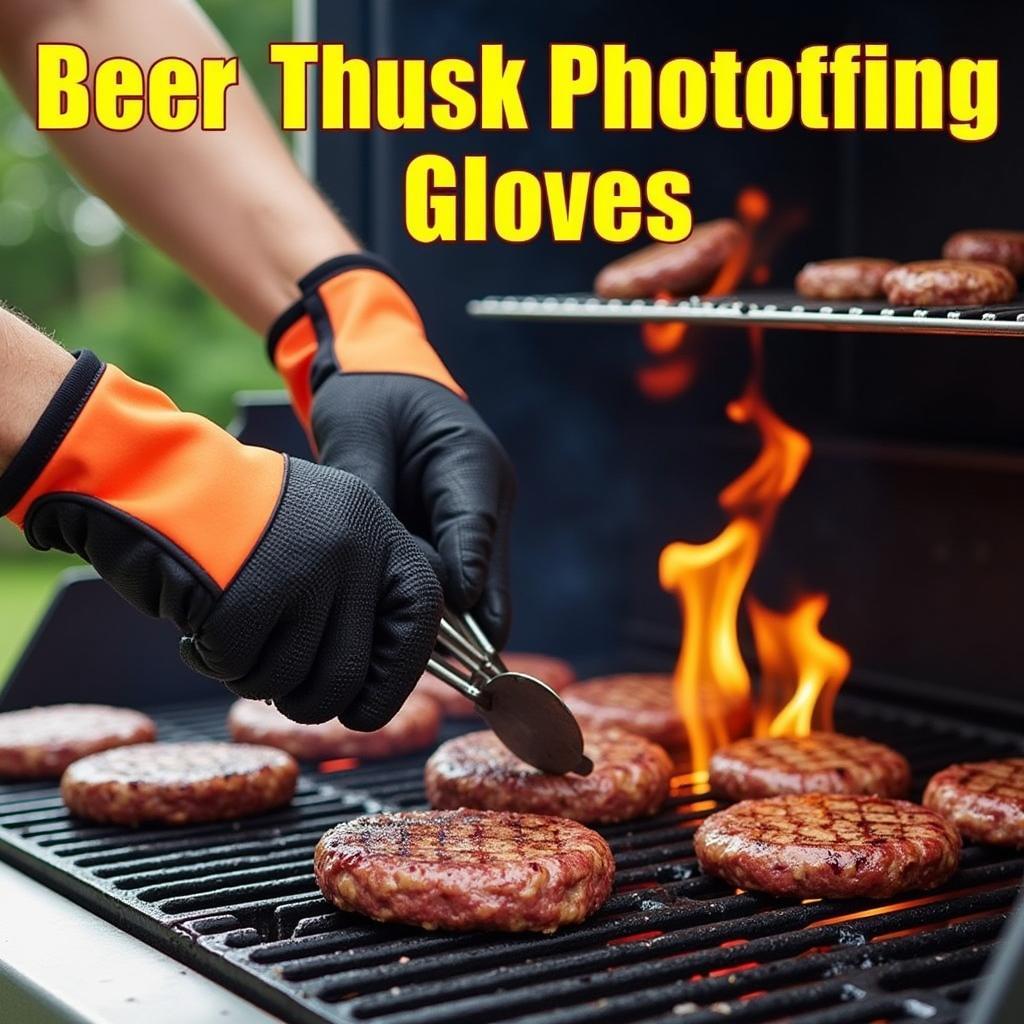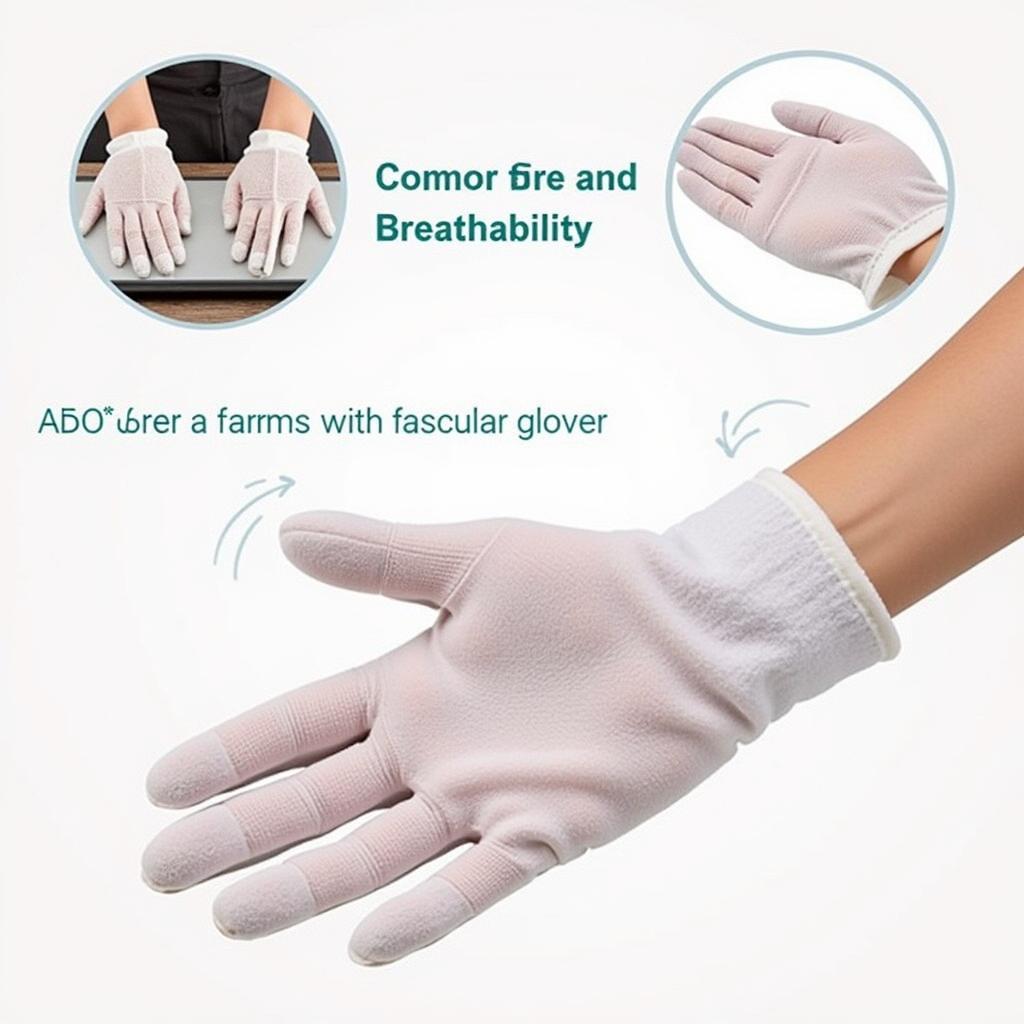Gloves For Handling Hot Food are essential for safety and efficiency in any kitchen, whether professional or at home. They protect your hands from burns and allow you to confidently handle hot items like baking trays, pots, and even food directly. But not all gloves are created equal. This comprehensive guide will delve into the different types of hot food gloves, their uses, and how to choose the best pair for your needs. Check out our selection of hot food gloves.
Types of Gloves for Handling Hot Food
Several materials are commonly used to make gloves designed for handling hot items. Each offers a different level of heat protection and dexterity. Understanding these differences is key to making the right choice.
Silicone Gloves
Silicone gloves are a popular choice due to their flexibility and heat resistance. They are generally able to withstand temperatures up to 400-500°F (204-260°C). They’re also waterproof, making them excellent for handling wet or greasy hot food. However, silicone can be prone to punctures, so it’s important to choose a durable, high-quality pair.
Neoprene Gloves
Neoprene gloves offer excellent heat protection, often exceeding that of silicone. They’re also highly durable and resistant to punctures and chemicals. This makes them ideal for heavy-duty tasks in both professional and home kitchens. However, they can be less flexible than silicone gloves, which might slightly reduce dexterity.
Fabric Gloves
Fabric gloves, often made from materials like cotton or aramid fibers (like Kevlar), offer good heat protection and breathability. They’re typically used as liners beneath other gloves, increasing comfort and absorbing sweat. Aramid fiber gloves, in particular, offer exceptional cut and heat resistance. They’re perfect for grilling and barbecuing. When using fabric gloves, always ensure they are appropriately rated for the intended temperature.
Choosing the Right Gloves for Handling Hot Food
Selecting the perfect hot food gloves depends on your specific needs and the tasks you’ll be performing. Consider the following factors:
- Heat Resistance: What is the maximum temperature you will be handling?
- Dexterity: Do you need fine motor control for intricate tasks?
- Durability: How often will you be using the gloves and in what environment?
- Comfort: How do the gloves feel on your hands? Are they breathable?
- Length: Do you need wrist or forearm protection?
Key Features to Look For
When shopping for gloves, pay attention to features like textured grips for improved handling, reinforced fingertips for added durability, and long cuffs for extended protection.
“Choosing the right glove can significantly impact your cooking experience,” says renowned chef, Amelia Dubois. “Prioritize quality and ensure the gloves fit your specific needs.”
 Neoprene BBQ Grilling Gloves for High-Heat Protection
Neoprene BBQ Grilling Gloves for High-Heat Protection
Caring for Your Hot Food Gloves
Proper care will extend the lifespan of your gloves. Always wash them according to the manufacturer’s instructions. Most silicone and neoprene gloves can be hand-washed or put in the dishwasher. Fabric gloves should be washed and dried thoroughly to prevent the growth of bacteria.
What are the benefits of using hot food gloves?
Using gloves for handling hot food provides numerous benefits, including preventing burns, improving grip, and enhancing hygiene. They also offer increased confidence when working with hot items. Need to clean your food truck’s sink? Check out our food truck sink system.
How do I choose the right size hot food gloves?
Choosing the right size ensures a snug fit and optimal dexterity. Most manufacturers provide size charts, and it’s always a good idea to measure your hand before purchasing. You may also want to look at our fuzzies snake food
 Fabric Heat-Resistant Glove Liners for Enhanced Comfort
Fabric Heat-Resistant Glove Liners for Enhanced Comfort
Conclusion
Gloves for handling hot food are an indispensable tool in any kitchen. By understanding the different types available and considering your specific needs, you can choose the perfect pair to ensure safety, efficiency, and comfort. Remember to prioritize quality, durability, and heat resistance for optimal protection. For your smoking needs, we also offer a range of food smoking accessories.
FAQ
- Can I use regular dishwashing gloves for handling hot food? No, regular dishwashing gloves are not designed for high temperatures and can melt or tear.
- How often should I replace my hot food gloves? Replace them when they show signs of wear and tear, such as cracks, holes, or significant discoloration.
- Are all hot food gloves oven-safe? Not all hot food gloves are oven-safe. Check the manufacturer’s instructions for specific temperature ratings.
- Can I use hot food gloves to handle frozen items? Yes, many hot food gloves are suitable for handling both hot and cold items.
- What are the best gloves for grilling? Neoprene or aramid fiber gloves are typically recommended for grilling due to their high heat resistance.
- How do I clean my hot food gloves? Follow the manufacturer’s instructions. Most can be hand-washed or machine-washed.
- Are there gloves for people with allergies? Yes, some gloves are made from hypoallergenic materials like silicone.
“Investing in a good pair of heat-resistant gloves is a small price to pay for the safety and convenience they offer,” adds Chef Dubois. You might also find our resource on food handlers permit answers utah helpful.
When you need assistance, please contact Phone Number: 02437655121, Email: minacones@gmail.com Or visit us at: 3PGH+8R9, ĐT70A, thôn Trung, Bắc Từ Liêm, Hà Nội, Việt Nam. We have a 24/7 customer service team.